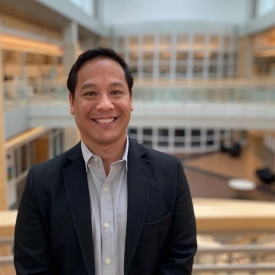NORMAN, Oklahoma - Because two-thirds of oral cancer diagnoses are made when the cancer is advanced, treating it usually requires complex surgeries, followed by reconstructive procedures that are necessary because tissue has been removed from the patient's face.
A University of Oklahoma researcher is developing computer technology and a new medical device that he hopes can detect oral cancer at an early stage, when the survival rate is much higher. Javier Jo, Ph.D., is a professor with the School of Electrical and Computer Engineering on OU's Norman campus, and a member of Stephenson Cancer Center at OU Medicine. His expertise in applying engineering concepts to solve a medical problem earned him a $2.5 million grant from the National Cancer Institute.
Jo's research involves creating a hand-held endoscope to look for precancerous and cancerous lesions of the mouth, and "training" it to recognize patterns and signatures of those lesions with more accuracy and at an earlier stage.
"When oral cancer is diagnosed early, treating the patient is much more effective and a lot less invasive," he said. "The survival rate and quality of life of the patient is fairly high if the cancer is detected early."
Jo's technology aims to address two problems in oral cancer detection. A person's general dentist is usually the first health provider to examine the tissue inside the mouth and search for lesions based on look and feel. However, it's difficult to distinguish a benign lesion from a cancerous or precancerous lesion, Jo said. In addition, dentists have varying degrees of experience in oral cancer screening.
If a dentist discovers a suspicious lesion, the patient will usually be referred to an oral pathologist, who may decide to do a tissue biopsy. However, because some lesions are quite large, the pathologist has to decide from which area to take the biopsy sample. Unfortunately, the pathologist may take a sample from a non-cancerous portion of the lesion, yet another area is cancerous, Jo said.
"Those are two main barriers to detecting oral cancer early," Jo said. "What's missing is an objective and quantitative tool to provide more precise information about the presence of malignant vs. benign lesions."
Jo is developing fluorescence imaging endoscopes and combining them with artificial intelligence technologies. When he shines light of a specific color into the tissues of a person's mouth, the molecules in those tissues respond by emitting light of their own, known as fluorescence. Because cancer cells divide very quickly, Jo is looking for changes in the fluorescence characteristics of specific molecules associated with increased cell activity - a hallmark of cancer cells.
At the current stage of his research, Jo's team is engineering the endoscopes, which will be sent to several clinical centers where patients with suspicious lesions will be imaged before having a biopsy to confirm whether oral cancer is present. This multicenter study will provide data to develop artificial intelligence algorithms that aim to distinguish between benign, precancerous and cancerous oral lesions.
"Once we have a computer algorithm that can discern different types of lesions, we can put that algorithm into the endoscope and test it on a larger group of patients to see if it works with enough accuracy to be clinically useful," Jo said.
Jo's aim is that the technology will first be used in the dentist's office for a more accurate determination of whether a patient needs to be referred to an oral pathologist. He also envisions an oral pathologist using the tool to determine which area of the lesion needs to biopsied.
Robert Mannel, M.D., Stephenson Cancer Center director and Rainbolt Family Chair in Cancer, said Jo's research has the potential to dramatically increase the number of oral cancer patients who are diagnosed at an earlier stage.
"We are excited by the prospects of Dr. Jo's innovative research," Mannel said. "Not only does it point to a promising avenue of improving patient outcomes through earlier cancer detection, it also underscores the close collaboration between Stephenson Cancer Center researchers at the OU Health Sciences Center and OU Norman campuses."

